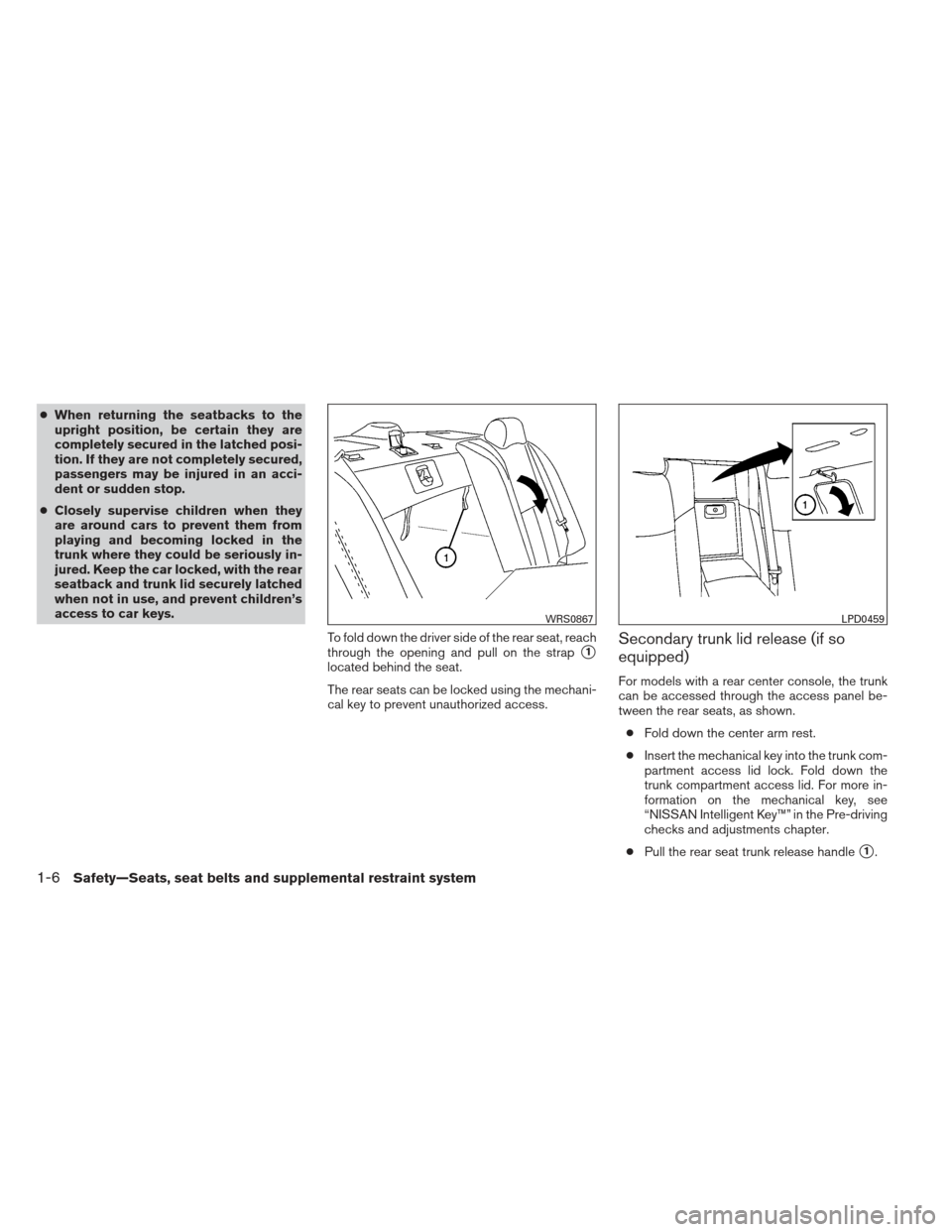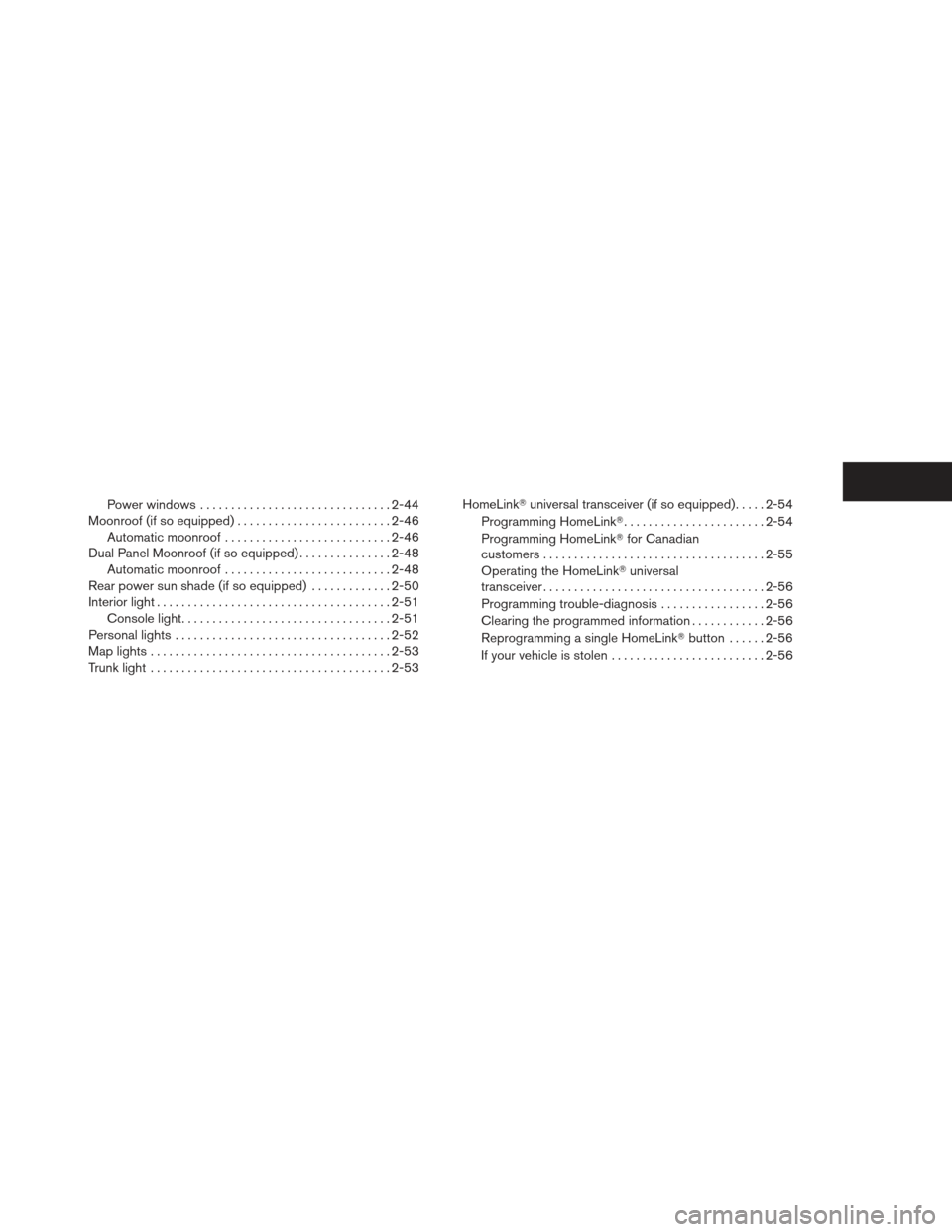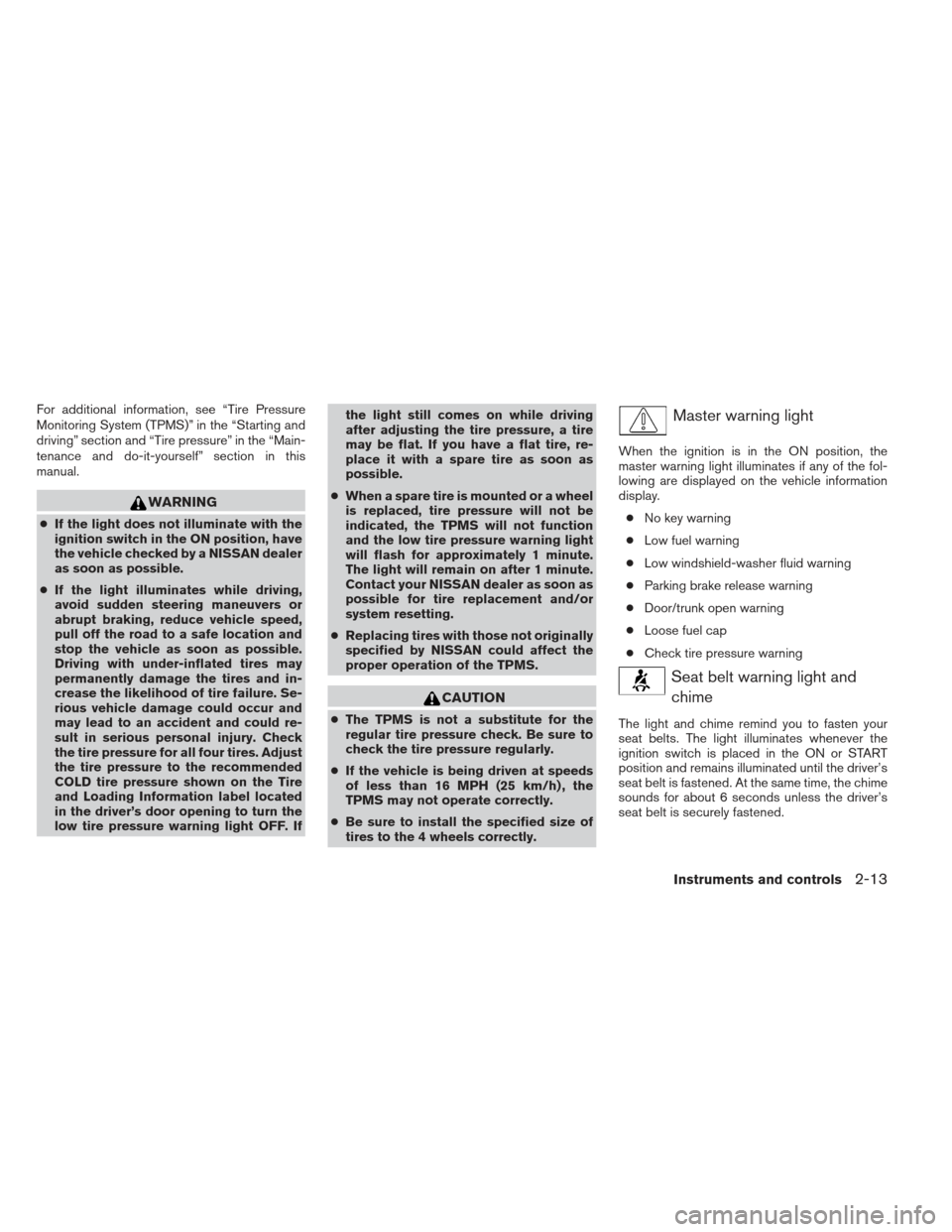Page 11 of 450
1. Rear window defroster switch (P. 2-29)
2. Interior trunk lid release (P. 3-20)
3. Trunk lid (P. 3-18)
4. Vehicle loading (P. 9-12)
5. Exterior trunk lid release/request button(P. 3-13)
6. Replacing bulbs (P. 8-29)
7. Fuel-filler cap, fuel recommendation
(P. 3-21, P. 9-3)
8. Fuel-filler door (P. 3-21)
9. Child safety rear door locks (P. 3-6)
See the page number indicated in paren-
theses for operating details.
WII0156
EXTERIOR REAR
0-4Illustrated table of contents
Page 12 of 450
1. Interior trunk access (P. 1-5)
2. Moonroof (if so equipped) (P. 2-46)
3. Sun visors (P. 3-25)
4. Interior lights, illuminated entry (P. 2-51)
5. HomeLink�universal transceiver
(if so equipped) (P. 2-54)
6. Interior mirrors (P. 3-26)
7. Glove box (P. 2-42)
8. Cup holders (P. 2-40)
9. Console box (P. 2-42)
10. Front seat (P. 1-2)
11. Rear seat (P. 1-5)
See the page number indicated in paren-
theses for operating details.
WII0126
PASSENGER COMPARTMENT
Illustrated table of contents0-5
Page 14 of 450
24. Vehicle Dynamic Control (VDC) OFFswitch (P. 2-38)
Outside mirror controls (P. 3-28)
Heated steering wheel switch
(if so equipped) (P. 2-37)
Trunk lid release switch (P. 3-20)
* Refer to the separate Navigation System Own-
er’s Manual (if so equipped) .
See the page number indicated in paren-
theses for operating details.
Illustrated table of contents0-7
Page 22 of 450
Thigh extension (driver’s side only, if
so equipped)
Pull up and hold the lever to extend the front
portion to the desired position.
FOLDING REAR SEAT (if so
equipped)Interior trunk access
For models without a rear center console, the
trunk can be accessed from the passenger side
of the rear seat for loading and unloading, as
shown.
�1Press down on the button on the rear parcel
shelf.
�2Fold down the passenger side seatback.
WARNING
● Never allow anyone to ride in the cargo
area or on the rear seat when it is in the
fold-down position. Use of these areas
by passengers without proper restraints
could result in serious injury in an acci-
dent or sudden stop.
● Properly secure all cargo with ropes or
straps to help prevent it from sliding or
shifting. Do not place cargo higher than
the seatbacks. In a sudden stop or col-
lision, unsecured cargo could cause
personal injury.
LRS0863
WRS0866
Safety—Seats, seat belts and supplemental restraint system1-5
Page 23 of 450

●When returning the seatbacks to the
upright position, be certain they are
completely secured in the latched posi-
tion. If they are not completely secured,
passengers may be injured in an acci-
dent or sudden stop.
● Closely supervise children when they
are around cars to prevent them from
playing and becoming locked in the
trunk where they could be seriously in-
jured. Keep the car locked, with the rear
seatback and trunk lid securely latched
when not in use, and prevent children’s
access to car keys.
To fold down the driver side of the rear seat, reach
through the opening and pull on the strap
�1
located behind the seat.
The rear seats can be locked using the mechani-
cal key to prevent unauthorized access.
Secondary trunk lid release (if so
equipped)
For models with a rear center console, the trunk
can be accessed through the access panel be-
tween the rear seats, as shown.● Fold down the center arm rest.
● Insert the mechanical key into the trunk com-
partment access lid lock. Fold down the
trunk compartment access lid. For more in-
formation on the mechanical key, see
“NISSAN Intelligent Key™” in the Pre-driving
checks and adjustments chapter.
● Pull the rear seat trunk release handle
�1.
WRS0867LPD0459
1-6Safety—Seats, seat belts and supplemental restraint system
Page 72 of 450

Power windows............................... 2-44
Moonroof (if so equipped) ......................... 2-46
Automatic moonroof ........................... 2-46
Dual Panel Moonroof (if so equipped) ...............2-48
Automatic moonroof ........................... 2-48
Rear power sun shade (if so equipped) .............2-50
Interior light ...................................... 2-51
Console light .................................. 2-51
Personal lights . .................................. 2-52
Map lights ....................................... 2-53
Trunk light ....................................... 2-53HomeLink�
universal transceiver (if so equipped) .....2-54
Programming HomeLink� .......................2-54
Programming HomeLink� for Canadian
customers .................................... 2-55
Operating the HomeLink� universal
transceiver .................................... 2-56
Programming trouble-diagnosis .................2-56
Clearing the programmed information ............2-56
Reprogramming a single HomeLink� button......2-56
If your vehicle is stolen ......................... 2-56
Page 74 of 450
24. Vehicle Dynamic Control (VDC) OFFswitch (P. 2-38)
Outside mirror controls (P. 3-28)
Heated steering wheel switch
(if so equipped) (P. 2-37)
Trunk lid release switch (P. 3-20)
* Refer to the separate Navigation System Own-
er’s Manual (if so equipped) .
See the page number indicated in paren-
theses for operating details.
1. Tachometer
2. Speedometer
3. Warning/indicator lights
4. Fuel gauge
5. Odometer/twin trip odometer
6. Trip odometer change button 7. Engine coolant temperature gauge
8. Vehicle information display
LIC1381
METERS AND GAUGES
Instruments and controls2-3
Page 84 of 450

For additional information, see “Tire Pressure
Monitoring System (TPMS)” in the “Starting and
driving” section and “Tire pressure” in the “Main-
tenance and do-it-yourself” section in this
manual.
WARNING
●If the light does not illuminate with the
ignition switch in the ON position, have
the vehicle checked by a NISSAN dealer
as soon as possible.
● If the light illuminates while driving,
avoid sudden steering maneuvers or
abrupt braking, reduce vehicle speed,
pull off the road to a safe location and
stop the vehicle as soon as possible.
Driving with under-inflated tires may
permanently damage the tires and in-
crease the likelihood of tire failure. Se-
rious vehicle damage could occur and
may lead to an accident and could re-
sult in serious personal injury. Check
the tire pressure for all four tires. Adjust
the tire pressure to the recommended
COLD tire pressure shown on the Tire
and Loading Information label located
in the driver’s door opening to turn the
low tire pressure warning light OFF. If the light still comes on while driving
after adjusting the tire pressure, a tire
may be flat. If you have a flat tire, re-
place it with a spare tire as soon as
possible.
● When a spare tire is mounted or a wheel
is replaced, tire pressure will not be
indicated, the TPMS will not function
and the low tire pressure warning light
will flash for approximately 1 minute.
The light will remain on after 1 minute.
Contact your NISSAN dealer as soon as
possible for tire replacement and/or
system resetting.
● Replacing tires with those not originally
specified by NISSAN could affect the
proper operation of the TPMS.
CAUTION
● The TPMS is not a substitute for the
regular tire pressure check. Be sure to
check the tire pressure regularly.
● If the vehicle is being driven at speeds
of less than 16 MPH (25 km/h) , the
TPMS may not operate correctly.
● Be sure to install the specified size of
tires to the 4 wheels correctly.
Master warning light
When the ignition is in the ON position, the
master warning light illuminates if any of the fol-
lowing are displayed on the vehicle information
display.
● No key warning
● Low fuel warning
● Low windshield-washer fluid warning
● Parking brake release warning
● Door/trunk open warning
● Loose fuel cap
● Check tire pressure warning
Seat belt warning light and
chime
The light and chime remind you to fasten your
seat belts. The light illuminates whenever the
ignition switch is placed in the ON or START
position and remains illuminated until the driver’s
seat belt is fastened. At the same time, the chime
sounds for about 6 seconds unless the driver’s
seat belt is securely fastened.
Instruments and controls2-13